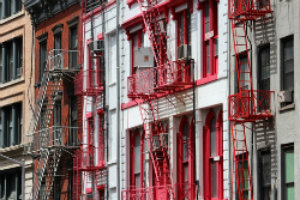Summary | Excerpt | Reading Guide | Reviews | Beyond the Book | Read-Alikes | Genres & Themes | Author Bio

This article relates to Tuesday Nights in 1980
Tuesday Nights in 1980 is set in the SoHo district of New York City, a neighborhood that was once far removed from the boutiques and arts destination it is today. SoHo is located in lower Manhattan and derives its name from its geography: South of Houston street and perhaps after its sister equivalent, Soho in London. It is widely believed that an urban planner, Chester Rapkin, was influential in SoHo getting its name, and referred to the district as such in a 1962 study. This nomenclature style might have lead to other names such as TriBeCa (Triangle Below Canal), that use similar principles.
It's hard to believe now but Manhattan in the 1600s was mostly grassy meadows and marshes settled by Native Americans. Early Dutch migrants set up a small settlement at the very south of Manhattan and for a while, their expansion northward was limited by natural boundaries such as large ponds. These were eventually filled over in the steady northward march.
 The nineteenth century saw today's SoHo as a mostly residential neighborhood with a smattering of hotels and shops. This was also the time when many bordellos set up business in surrounding areas and the neighborhood became the city's first red-light district. Services were advertised in guidebooks with one famous one recommending Miss Clara Gordon at No. 119 Mercer Street:
The nineteenth century saw today's SoHo as a mostly residential neighborhood with a smattering of hotels and shops. This was also the time when many bordellos set up business in surrounding areas and the neighborhood became the city's first red-light district. Services were advertised in guidebooks with one famous one recommending Miss Clara Gordon at No. 119 Mercer Street:
"We cannot too highly recommend this house, the lady herself is a perfect Venus: beautiful, entertaining, and supremely seductive. Her aidesdecamp are really charming and irresistible, and altogether honest and honorable. Miss G. is a great belle, and her mansion is patronized by Southern merchants and planters principally. She is highly accomplished, skillful, and prudent, and sees her visitors are well entertained. Good wines of the most elaborate brands, constantly on hand, and in all, a finer resort cannot be found in the City."
The late nineteenth century saw residences move away, accompanied by an increase in industries, primarily textiles. Artists of various stripes slowly made their way to the district in the 1950s and have been a part of the local scene ever since. The historic nature of the neighborhood was under threat in the 1960s when the local government launched plans for a highway that would change the character of much of the neighborhood. Protest against these plans were so fevered that the project was scrapped but not before many commercial buildings were left abandoned. Attracted by cheap rents, artists eventually took over these areas and converted them to lofts.
 The SoHo district is known as the Cast Iron District because of the many buildings with cast iron facades. These were used to dress up structures that could use a lift and cast iron remodeling was cheaper than a complete makeover. One of the most famous cast-iron buildings is the Haughwout, named for the emporium that it originally housed which sold upmarket household goods including china and glassware, and was the location of the first elevator in the world.
The SoHo district is known as the Cast Iron District because of the many buildings with cast iron facades. These were used to dress up structures that could use a lift and cast iron remodeling was cheaper than a complete makeover. One of the most famous cast-iron buildings is the Haughwout, named for the emporium that it originally housed which sold upmarket household goods including china and glassware, and was the location of the first elevator in the world.
SoHo was designated a historic district by New York City's Landmarks Preservation Commission, which means historically and architecturally significant buildings are preserved. Unfortunately this hasn't prevented mainstream retailers from setting up shop.
Picture of SoHo from Depositphotos.com
Picture of The Haughwout building in 1859 from Library of Congress
Filed under Places, Cultures & Identities
![]() This "beyond the book article" relates to Tuesday Nights in 1980. It originally ran in April 2016 and has been updated for the
May 2017 paperback edition.
Go to magazine.
This "beyond the book article" relates to Tuesday Nights in 1980. It originally ran in April 2016 and has been updated for the
May 2017 paperback edition.
Go to magazine.
Your guide toexceptional books
BookBrowse seeks out and recommends the best in contemporary fiction and nonfiction—books that not only engage and entertain but also deepen our understanding of ourselves and the world around us.